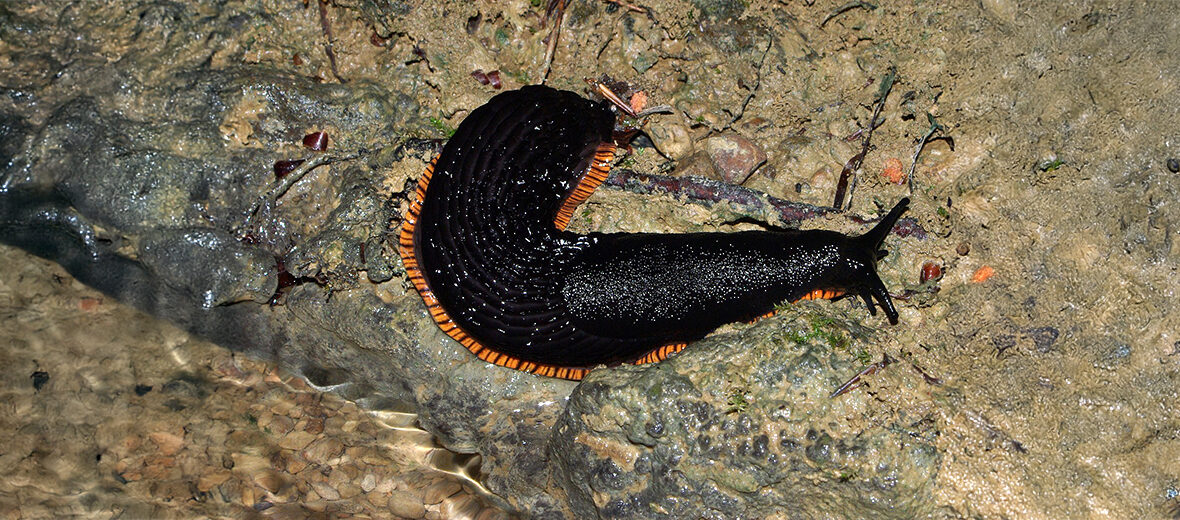
The black slug, aka black arion, European black slug, or large black slug, can be found throughout much of Europe. These critters are large terrestrial gastropod mollusks in the family Arionidae (the round back slugs). They can be found in Faroe Islands, Finland, Germany, Iceland, Ireland, Isle of Man, Lithuania, Norway, Spain, Sweden, Northern Ireland, and Great Britain. These slugs are also considered an invasive species in Australia and North America. These slugs face the threat of invasive species (ironically enough) that can bring disease and increased predation. However, they are abundant enough to be listed as Least Concern by the IUCN. Their populations are also stable.
First the Stats…
Scientific name: Arion ater
Weight: Up to .95 ounce
Length: Up to 5.9 inches
Lifespan: Up to 2 years
Now on to the Facts!
1.) Such is the case with all land slugs, they have a vestigial shell. This means they have but a remnant of a shell inside their body. But not an external shell, like other land and aquatic snails.
2.) Terrestrial slugs produce 3 forms of mucus that facilitate locomotion and prevent death from desiccation (drying out). The 3rd type of mucus is a nasty-tasting substance which helps prevent predation.
3.) Fungi, carrion (dead animals), earthworms, leaves, stems, dead plant material, and dung (poop) make up their diet.
4.) Their food is shredded into tiny pieces by the radula (tiny teeth used for scraping food particles off a surface and drawing them into the mouth) and is then digested by enzymes.
5.) Like other members of the Arionidae family, the black slug has a pneumostome (breathing hole) on the right side of its mantle from which it respirates (breathes).
But wait, there’s more on the black slug!
6.) These mollusks are hermaphroditic (produce male and female gametes).
7.) Like other terrestrial slugs, as a hermaphrodite, they prefer to find a mate, typically several, but can also self-fertilize.
Did you know…?
While these slugs are edible, their consumption is typically discouraged due to potential pesticide contamination and the risk of carrying parasites.
8.) Between August – October, an individual slug can lay up to 150 eggs every 1 – 3 weeks, with clutches reducing to 20 eggs late in the season.
9.) Juveniles hatch in up to 27 days.
10.) Adults die shortly after laying their last clutch of eggs, typically living no more than 2 years.
But wait, there’s more on the black slug!
11.) These slugs are nocturnal (active at night).
12.) Hedgehogs, badgers, shrews, moles, mice, frogs, toads, snakes, carnivorous beetles, and some birds all prey on these slugs.
Did you know…?
A 2014 study researched the black slug gut’s microbiology in the hopes of catalyzing other studies of cellulolytic activity that could actually improve biofuel technology.
13.) When startled, the black slug will contract to a hemispherical shape and begin to rock from side to side. This behavior is unique to this family of slugs.
14.) As an invasive species, these slugs have mated with the non-native pest species Spanish slugs and this has resulted in a more resilient hybrid that displays an increased tolerance to cold.
15.) Black slugs were used as grease to lubricate wooden axle-trees or carts in Sweden. This use is documented since at least the 18th century.
Now a Short Black Slug Video!
This video talks about slugs in general.
Be sure to share & comment below! Also, check out the Critter Science YouTube channel. Videos added regularly!
Want to suggest a critter for me to write about? Let me know here.
Some source material acquired from: Wikipedia & IUCN
Photo credit: David Perez




